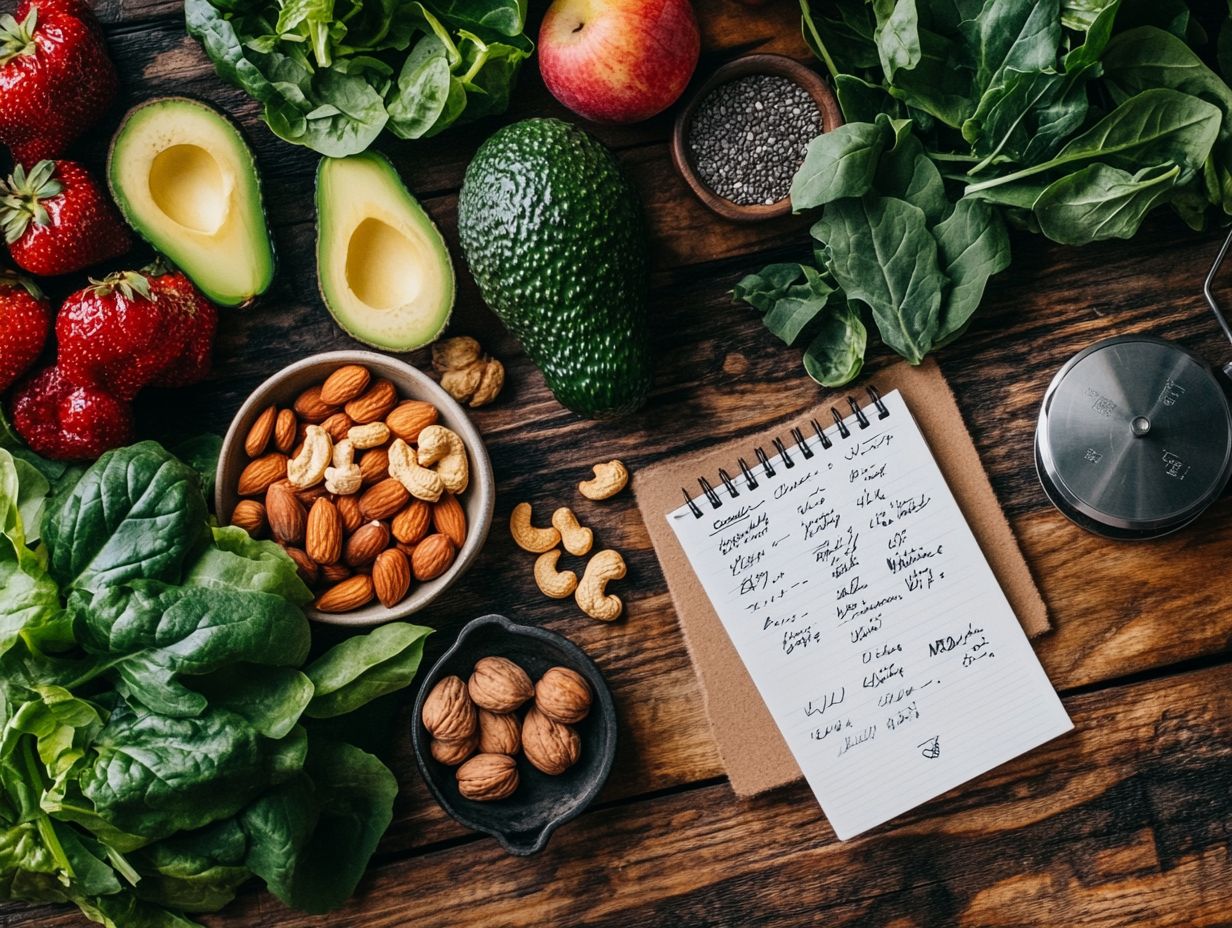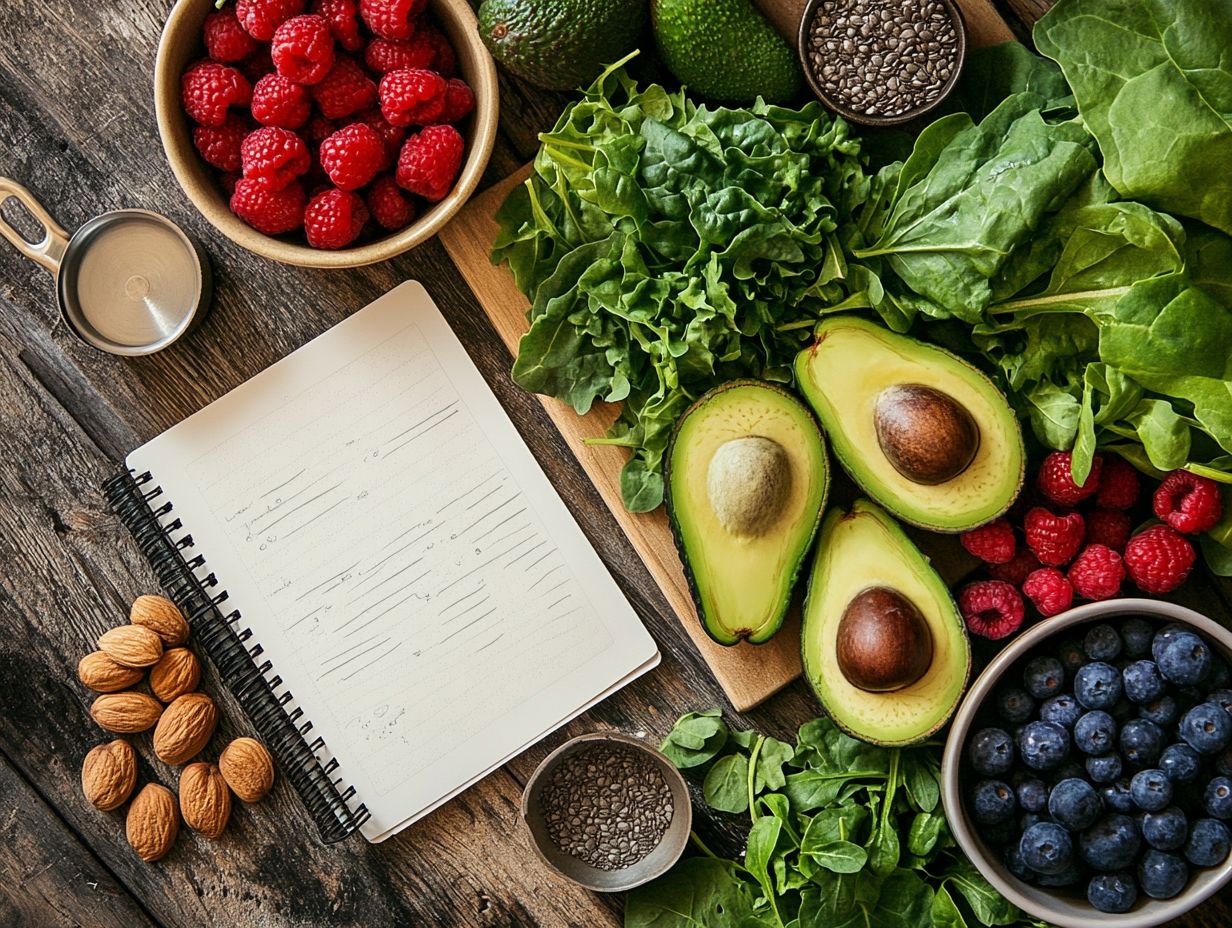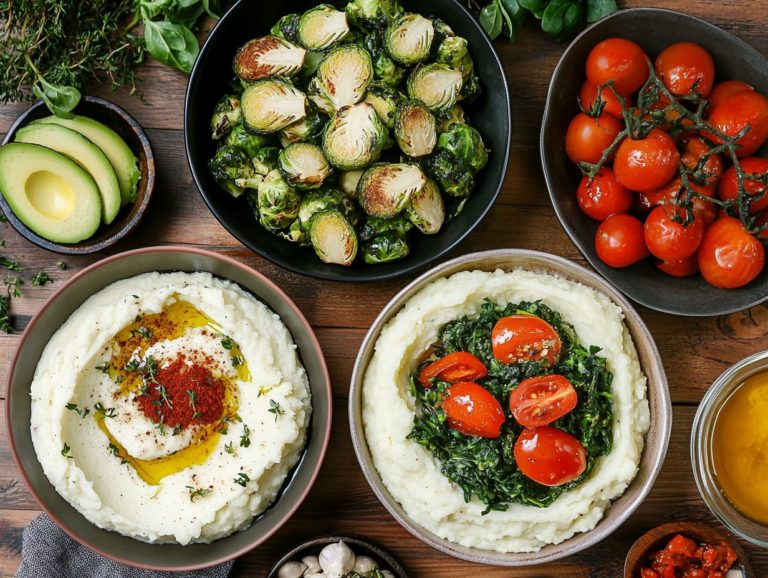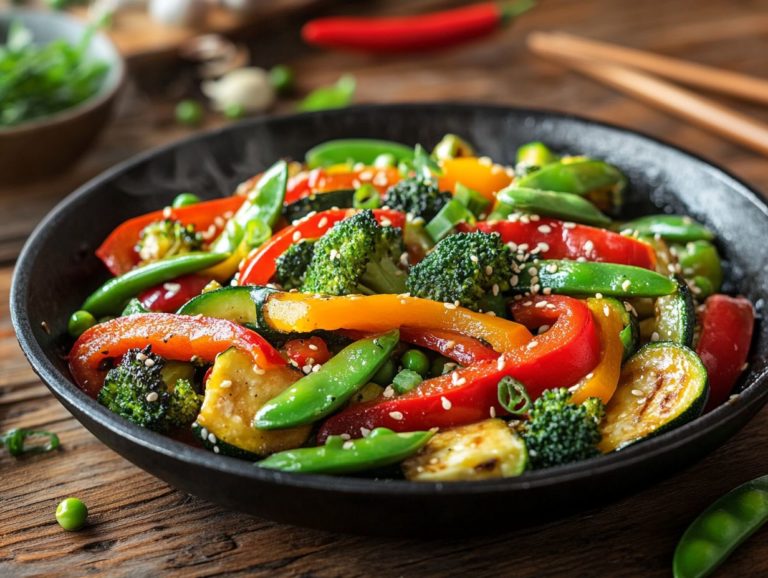How to Create a Keto Meal Plan
Are you intrigued by the ketogenic diet and eager to design a personalized meal plan that aligns with your lifestyle, including your specific dietary needs and food preferences?
A keto meal plan focuses on low carbohydrates and high fats, delivering an array of health benefits, including weight loss, improved blood sugar control, and enhanced energy levels.
This article delves into the essentials of a keto meal plan, highlighting its benefits and providing practical steps for creating your own. You’ll find sample meal plans, grocery lists, and valuable tips to guide you toward success on your keto journey.
Get ready to transform your eating habits with exciting meal ideas and snack options!
Contents
- Key Takeaways:
- What Is a Keto Meal Plan?
- What Are the Benefits of a Keto Meal Plan?
- How to Create a Keto Meal Plan?
- Keto Meal Planning: A Guide to Achieving Your Goals
- What Are Some Sample Keto Meal Plans?
- Tips for Success with a Keto Meal Plan
- 4. Don’t Be Afraid to Modify Your Plan
- Frequently Asked Questions
Key Takeaways:

- Creating a keto meal plan involves determining daily calorie intake, choosing macronutrient ratios, and incorporating low-carb, high-fat foods, including healthy fats and vegetable options.
- Benefits of following a keto meal plan include weight loss, improved blood sugar control, increased energy levels, reduced inflammation, and better management of health conditions such as diabetes and obesity.
- Tips for success with a keto meal plan: stay hydrated, listen to your body, prevent keto flu by maintaining electrolyte balance, be mindful of hidden carbs, and don’t be afraid to modify your plan according to your dietary restrictions.
What Is a Keto Meal Plan?
A keto meal plan is a carefully crafted dietary strategy aimed at guiding you into a state of ketosis. In this state, your body shifts to burning fat as its primary energy source instead of carbohydrates. This shift paves the way for significant weight loss and a host of health benefits, particularly for conditions such as epilepsy, diabetes, and obesity.
This approach emphasizes low-carb, high-fat foods. It also ensures you get enough protein to preserve muscle while losing weight. It’s important to also focus on nutrient-dense snacks and avoid sugar cravings by choosing unsweetened beverages.
When designing a successful keto meal plan, it s crucial to consider your daily calorie needs, macronutrient ratios, effective meal prep strategies, and appropriate cooking methods that resonate with your personal dietary goals and preferences.
What Are the Benefits of a Keto Meal Plan?
The health benefits of a keto meal plan extend to various conditions, including epilepsy, diabetes, and obesity. The advantages of adopting a keto meal plan go far beyond mere weight loss. You ll experience improved blood sugar control, heightened energy levels, and reduced inflammation, making this dietary approach particularly appealing for those dealing with health challenges like diabetes and obesity.
By following this high-fat, low-carb regimen, you enable your body to produce ketones, which act as an alternative energy source. This helps your body burn fat effectively and improves your overall health. It can also ease symptoms of keto flu and help your metabolism work better.
1. Weight Loss
Weight loss stands out as one of the most celebrated benefits of embracing a keto diet. This lifestyle shift encourages your body to enter a metabolic state known as ketosis, where it effectively burns body fat for energy. Not only does this process lead to rapid weight loss, but it also helps reduce your body fat percentage while preserving lean muscle mass an essential factor for maintaining sustainable health.
In this state, your liver converts fatty acids into ketones, providing a viable energy source that can be especially advantageous for you if you’re aiming to shed those stubborn extra pounds. By significantly cutting back on carbohydrate intake, your insulin levels will naturally decline. This drop in insulin makes it easier for your body to break down fat and control hunger, allowing you to stick to a meal plan that keeps you feeling satisfied and supports long-term weight management.
Thus, the keto approach not only encourages fat burning but also enhances metabolic flexibility, enabling your body to utilize stored fat more efficiently while keeping unwanted fat gain at bay.
2. Improved Blood Sugar Control
One of the standout benefits of a ketogenic diet is its remarkable ability to enhance blood sugar control. This is especially beneficial for those navigating diabetes and other health conditions. By minimizing carbohydrate intake, you can effectively stabilize insulin levels. Reducing high glycemic index foods helps maintain more balanced blood sugar levels, which is essential for long-term health.
Numerous studies suggest that embracing a ketogenic diet leads to significant decreases in fasting insulin levels and improved insulin sensitivity. For example, research published in the journal *Nutrition & Metabolism* revealed that participants experienced a reduction in hemoglobin A1c levels a critical marker of blood sugar control after adopting this high-fat, low-carb approach. This is particularly beneficial for those using insulin drugs to manage type 2 diabetes.
If you typically depend on insulin medications, you may find that managing your carbohydrate intake more strategically allows for reduced medication doses. This showcases the diet’s potential in diabetes management. Adopting established dietary guidelines alongside the ketogenic method can grant you enhanced metabolic health and a clearer path toward achieving overall wellness.
3. Increased Energy Levels
Embracing a ketogenic diet can significantly elevate your energy levels. Your body adapts to using ketones as its primary energy source instead of carbohydrates. This transition provides a more stable and sustained energy supply throughout the day. Not only does this boost your physical performance, but it may also enhance your mental clarity and focus. This makes it an appealing choice for anyone seeking to elevate productivity.
As you shift from relying on glucose to metabolizing fat, your body begins to tap into stored fat reserves. This creates a more efficient fat-burning state. Incorporating healthy fats from sources like avocados, nuts, and olive oil is essential in this journey. These sources provide the necessary nutrients and energy to fuel your daily activities while preventing nutritional deficiencies and promoting overall health.
This new metabolic state allows you to experience sustained energy without the dreaded crashes often linked to high-carb diets. It grants you a heightened sense of vitality. The ketogenic approach also helps reduce sugar cravings, further supporting your energy levels and overall well-being.
4. Reduced Inflammation
The ketogenic diet is known for its ability to reduce inflammation in the body. This can be especially advantageous if you re grappling with chronic inflammatory conditions like arthritis and obesity. This exciting dietary approach highlights the power of wholesome sources of fat, particularly omega-3 fatty acids, which are essential in fighting inflammation and promoting overall well-being.
By significantly cutting back on carbohydrates, your body enters a state of ketosis, relying on stored fats for energy. This transition stabilizes your blood sugar levels and diminishes oxidative stress, a factor that contributes to inflammation.
Research suggests that the ketogenic diet can improve important health markers such as cholesterol levels and insulin sensitivity. It effectively tackles obesity-related inflammation. As a result, you may find relief from symptoms, enhancing your quality of life, especially when dealing with conditions like inflammatory bowel disease or certain neurodegenerative disorders.
When carefully structured, a ketogenic diet can become a powerful ally in managing inflammation and fostering better health outcomes.
How to Create a Keto Meal Plan?

Crafting a personalized keto meal plan necessitates a thoughtful approach to your daily calorie intake, macronutrient ratios, and individual food preferences. This way, you can adhere to the tenets of a low-carb, high-fat diet while indulging in a delightful array of meals. Be sure to consider dietary restrictions and seek advice from a nutritionist or health professional to ensure balanced nutrition.
By gaining insight into your dietary needs and implementing effective meal prep strategies, you enable yourself to manage your weight loss journey and enhance your overall health.
Keto Meal Planning: A Guide to Achieving Your Goals
1. Determine Your Daily Calorie Intake
Determining your daily calorie intake is an essential first step in crafting an effective keto meal plan. This foundation is key for weight management, ensuring that your body receives the energy it needs while promoting fat loss. Consulting with a health professional can help you establish caloric goals tailored specifically to your individual needs and prevent potential nutritional deficiencies.
To accurately calculate your daily calorie requirements, it s important to consider several factors, such as your age, gender, weight, and activity level. For instance, younger individuals typically have higher metabolic rates compared to older adults, while men generally require more calories than women. If you lead an active lifestyle, your caloric needs will be greater than those of someone who is sedentary. Utilize the guidance of a nutritionist to tailor these factors to your ketogenic diet.
Once you ve assessed these factors, use formulas like the Harris-Benedict equation to determine your basal metabolic rate (BMR) and make adjustments based on your activity level. This approach is particularly beneficial when following a keto diet, as it helps ensure you re not only meeting your caloric needs but also optimizing your intake. This way, you can avoid potential nutritional deficiencies and support long-term weight management while effectively managing your weight.
2. Choose Your Macronutrient Ratio
Choosing the right macronutrient ratio is essential for achieving and maintaining ketosis. A typical ketogenic diet consists of approximately 70-75% fats, 20-25% proteins, and only 5-10% carbohydrates. By carefully adjusting your macronutrient intake, you can effectively influence ketone production and enhance your body s ability to burn fat for energy. This balance is crucial for maintaining a metabolic state conducive to long-term health benefits and effective weight management.
Understanding how to balance fats, proteins, and carbohydrates is crucial as you embark on this ketogenic diet journey. It s not merely about cutting down on carbs; the quality and source of the fats and proteins you consume significantly impact your overall health and energy levels.
Prioritize healthy fats like avocados, nuts, and olive oil, and consider incorporating protein sources such as lean meats, fish, and plant-based options.
Monitor and adjust these ratios based on your activity levels and dietary preferences. This ensures your body remains in a state of ketosis while still receiving the essential nutrients it needs for optimal functioning.
3. Plan Your Meals Around Low-Carb, High-Fat Foods
Exciting meals await you when you plan around low-carb, high-fat foods! This approach not only aligns your meals with the principles of ketosis but also opens up a world of delicious options. Focus on incorporating healthy fats, lean proteins, and low-carb vegetables into your meal prep and meal plan, allowing you to create satisfying and nutritionally balanced dishes.
By choosing ingredients like avocados, nuts, fatty fish, and olive oil as key fat sources, you can fuel your body with the energy it craves while keeping carbohydrate intake in check. If you’re searching for meal inspiration, think about preparing:
- Zesty chicken salad with olive oil dressing
- Grilled salmon paired with asparagus drizzled in butter
- Hearty vegetable stir-fries featuring vibrant broccoli and bell peppers
When you hit the grocery store, be vigilant about labels to avoid hidden sugars, and make sure your grocery list includes organic produce whenever possible. With a dash of creativity and thoughtful planning, you can effortlessly whip up mouthwatering meals that support your health and tantalize your taste buds, making your commitment to a keto lifestyle not just achievable but truly enjoyable.
Start your keto journey today and explore amazing recipes that will transform your meals into healthy, flavorful experiences!
What Are Some Sample Keto Meal Plans?
Exploring sample keto meal plans offers invaluable insights and inspiration as you consider adopting the ketogenic diet for weight loss or other health benefits. These plans demonstrate how to structure your meals effectively and guide you in following the essential low-carb, high-fat principles.
You’ll find various options, from a straightforward 7-day meal plan for beginners to more extensive 30-day plans that cater to diverse dietary preferences. These resources can help you navigate your keto journey with confidence and creativity!
1. 7-Day Keto Meal Plan for Beginners

A 7-day keto meal plan for beginners is your gateway to embracing the ketogenic diet with ease. This meal plan is designed to make your transition into ketosis as smooth as possible. It features a delightful array of low-carb meals that cater to your needs, helping to prevent the symptoms of keto flu.
You ll find a variety of options for breakfast, lunch, dinner, and snacks. This ensures you receive a well-rounded introduction to keto-friendly eating, even if you have specific dietary restrictions.
Each day is thoughtfully crafted to prioritize high-quality proteins, nutrient-dense vegetables, and healthy fats. This combination sustains your energy levels while promoting weight loss. Imagine starting your day with a satisfying breakfast of avocado and eggs, setting a positive tone for the hours ahead!
For lunch, enjoy a grilled chicken salad that keeps you full without exceeding your carbohydrate limits. As the day winds down, dinner could feature salmon with asparagus, rich in omega-3 fatty acids. Snacks like cheese sticks or almond butter with celery provide delicious options throughout the day.
This structured approach not only helps you grasp the concept of portion control but also reveals the exciting variety that a low-carb lifestyle offers. It s designed to be both manageable and enjoyable for anyone just starting their keto journey!
2. 30-Day Keto Meal Plan for Weight Loss
A 30-day keto meal plan for weight loss offers you a comprehensive strategy to shed those extra pounds. You will reap the benefits of a ketogenic diet.
This thoughtfully crafted meal plan presents a variety of meal ideas that cater to diverse tastes and dietary preferences. It makes it easier for you to stick to low-carb eating throughout the month and aids in your weight management.
Weekly Grocery Lists
With a well-organized outline of weekly grocery lists, cooking methods, and snack options, this resource simplifies meal preparation and planning. It allows you to focus on what truly matters: your health and well-being.
As you embark on your weight management journey, you’ll discover an array of flavorful recipes that feature healthy food substitutes. This ensures that monotony stays far away.
Cooking Techniques
From zesty cauliflower rice stir-fries to creamy avocado smoothies, the meal plan invites you to unleash your culinary creativity in the kitchen. By incorporating easy-to-follow cooking techniques like grilling, roasting, and saut ing you can stay motivated and committed to your keto lifestyle.
This structured approach not only fosters sustainable eating habits but also enables you to make informed decisions about your nutrition. It sets the stage for lasting change and success on your journey to better health.
3. Keto Meal Plan for Vegetarians
Creating a keto meal plan for vegetarians can feel like a daunting task, but with meticulous planning, you can savor low-carb meals that cater to your dietary restrictions. These meals still deliver ample protein and healthy fats.
This tailored meal plan showcases a delightful range of vegetarian-friendly options that align seamlessly with keto principles. You will enjoy a balanced and nutritious diet.
Low-Carb Protein Sources
By emphasizing an array of low-carb protein sources such as tofu, tempeh, and seitan, you can meet your protein needs without compromise. This ensures your body burns fat efficiently.
Incorporating healthy fats from sources like avocados, nuts, seeds, and olive oil not only elevates the flavor of your dishes but also helps you achieve the critical fat intake essential for a successful ketogenic diet.
Culinary Exploration
Experimenting with various cooking techniques whether grilling, baking, or saut ing can truly highlight the natural flavors of these ingredients. This transforms your meals into exciting culinary experiences.
By diversifying your food choices and venturing into different cuisines, you can uncover a treasure trove of delicious, satisfying meals that fit harmoniously within the keto framework. This ensures you meet your macronutrient goals.
4. Keto Meal Plan for Athletes
A keto meal plan designed specifically for athletes prioritizes maintaining peak energy levels and performance while adhering to low-carb dietary principles. It utilizes ketones as an energy source.
It ensures you receive adequate protein and healthy fats to support both your training and recovery needs. All while respecting your ketogenic goals.
High-Protein Meal Selection
By thoughtfully selecting meals rich in high-protein options like chicken, fish, and plant-based sources such as tofu or tempeh, you can maximize endurance and promote effective fat adaptation.
Incorporating energy sources like avocados, nuts, and coconut oil provides the essential fats necessary for sustained performance.
Meal Timing
Meal timing is critical in this strategy. You should aim to consume meals rich in protein and fats before your workouts to fuel your sessions effectively. Reserve post-exercise periods for recovery-focused meals.
This tailored approach not only elevates your energy levels but also enhances your overall athletic performance. It paves the way for optimal training outcomes.
Tips for Success with a Keto Meal Plan
To achieve success with your keto meal plan, it s essential to embrace specific strategies. These will help you gracefully navigate the initial transition and sustain your dietary changes over the long term.
By incorporating effective tips like prioritizing hydration and being aware of the potential symptoms of keto flu you can significantly enhance your experience while following a ketogenic diet.
Start your 30-day journey today and discover the delicious world of keto!
1. Stay Hydrated
Staying hydrated is essential when you re following a keto diet. It alleviates those pesky symptoms of keto flu and supports your overall health and well-being. When you’re adequately hydrated, your body can efficiently navigate the dietary changes that come with embracing a ketogenic lifestyle, especially during the initial adjustment phase.
Proper hydration plays a critical role in maintaining your energy levels and preventing common side effects that can derail your progress, such as fatigue, dizziness, and headaches. Make it a priority to monitor your fluid intake, aiming for at least 8 to 10 cups of water each day, with adjustments based on your activity level and environment.
Incorporate electrolyte-rich beverages like bone broth or electrolyte supplements to boost hydration. You can also add hydrating foods like leafy greens or cucumbers to your meals. This enhances fluid intake, assists with effective daily calorie management, and promotes your overall vitality during the keto transition.
2. Listen to Your Body
Listening to your body is crucial when following a keto meal plan. It helps you understand how your body adapts to dietary changes and enables you to make necessary adjustments. By paying attention to your energy levels, hunger cues, and overall health, you ensure a more enjoyable and sustainable keto experience.
Recognizing these personal physical cues enables you to optimize the right balance of fats, proteins, and carbs based on how you feel whether that involves adjusting your fat intake to combat fatigue or fine-tuning your carbs to soothe cravings. As your body transitions into ketosis, the state your body enters when it burns fat for energy instead of carbs, you may experience fluctuations in energy and mood; embracing these signals is crucial for your success.
Consulting with health professionals can provide you with personalized strategies and guidance, ensuring that your dietary practices align with your unique health status and fitness goals. This proactive approach not only deepens your understanding of your body but also enhances the overall effectiveness of your ketogenic lifestyle.
3. Be Mindful of Hidden Carbohydrates

Being mindful of hidden carbohydrates is crucial for successfully navigating a keto diet. Many packaged and processed foods harbor unexpected carb content that can easily disrupt your ketosis. By carefully examining your food choices during grocery shopping, you can make informed decisions that align with your ketogenic goals and steer clear of potential nutritional deficiencies.
To effectively spot these carbs, having a solid grasp of food labels is essential. Begin by looking out for ingredients that hint at sugar or grain derivatives, as these often contribute significant carb counts without being immediately apparent.
Prioritize whole foods such as fresh vegetables, meats, and dairy, which generally boast clearer nutritional profiles. It s wise to scan the nutrition facts panel for unexpected sources of carbs, including dressing, sauces, and snacks that may contain added sugars or refined grains.
Investing time in decoding what s in your food enables you to make better dietary choices, ultimately reinforcing your commitment to a low-carb lifestyle. You have the power to enhance your keto journey by staying informed about these carbs!
4. Don’t Be Afraid to Modify Your Plan
Don t hesitate to tailor your keto meal plan to better fit your personal tastes and dietary needs. Personalization can significantly enhance your adherence and overall success on this ketogenic journey. Recognizing that keto isn t a one-size-fits-all approach enables you to craft a plan that truly resonates with your unique lifestyle.
Feel free to experiment with a variety of flavors, textures, and cooking methods to keep your keto meals intriguing and satisfying. For instance, if Italian cuisine is your passion, try swapping traditional pasta for zucchini noodles or cauliflower rice. This way, you can savor your favorite dishes while keeping your carb count in check.
Explore a range of snacks that delight your taste buds think cheese crisps, nut butter paired with celery sticks, or homemade keto-friendly granola. These options can be carefully crafted to align with both your flavor preferences and dietary restrictions.
Remember, meal prep is crucial in easing your transition into keto. Having delicious options readily available ensures that your journey remains enjoyable and sustainable, allowing you to indulge without compromising your goals.
Frequently Asked Questions
What is a keto meal plan?
A keto meal plan is a dietary plan that focuses on consuming high amounts of healthy fats, moderate amounts of protein, and very low amounts of carbohydrates. This type of diet puts your body in a state where it burns fat for energy instead of sugar.
How do I create a keto meal plan?
To create a keto meal plan, start by calculating your daily calorie and macronutrient needs. Then, choose keto-friendly foods such as avocados, eggs, meats, and leafy greens to create meals that fit your daily requirements. It’s also important to track your food intake and adjust your plan accordingly.
Do I need to count calories on a keto meal plan?
While calorie counting is not necessary on a keto meal plan, it can be helpful in ensuring you are in a caloric deficit if weight loss is your goal. However, the focus should be on consuming healthy, whole foods rather than solely counting calories.
Can I eat snacks on a keto meal plan?
Yes, you can eat snacks on a keto meal plan as long as they fit within your daily macronutrient and caloric needs. Some keto-friendly snack options include nuts, cheese, and low-carb vegetables with dips like guacamole or hummus.
What are the benefits of following a keto meal plan?
Some potential benefits of following a keto meal plan include weight loss, improved blood sugar control, increased energy levels, and reduced inflammation in the body. It may also help with certain medical conditions such as epilepsy and PCOS.
Is a keto meal plan suitable for everyone?
A keto meal plan is not suitable for everyone. It is important to consult with a healthcare professional before starting this diet. It may not be suitable for those with certain medical conditions or those who are pregnant or breastfeeding. It’s important to listen to your body and make adjustments as needed.
Feel excited to start crafting your personalized keto meal plan today!






